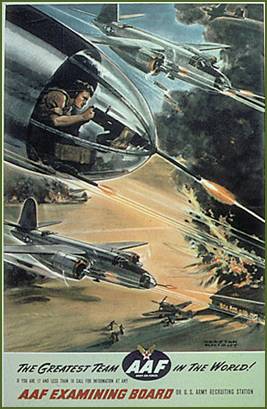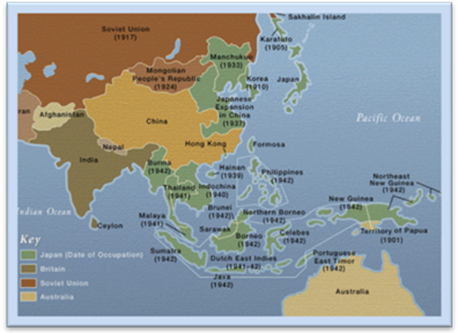WORLD WAR II

U.S. World War II
Recruiting Poster
Unit
Overview
In
September of 1939, Adolf Hitler ordered his German forces to cross the border
into Poland.† Having realized that the
Fuhrerís promises were meaningless, Great Britain and France reluctantly
declared war.† Thus, the most destructive
conflict in human history began.† Japan
continued its aggressive policies in Asia, and the war soon reached global
proportions.† Advanced weaponry blurred
the former lines between military and civilian targets as national leaders
mobilized their citizens and industries for the massive struggle.† Letís see how it all happened.
STOP:† Answer Section A Questions
The
Invasion of Poland
Although
Adolph Hitler had assured both
Britain and France that he would demand no more territory, the German leader
ordered his military commanders to prepare for an invasion of Poland on
September 1, 1939.† On the night of
August 31, a small group of German soldiers wearing Polish uniforms pretended
to seize a German radio station on the border between Poland and Germany.† Hitler
announced that the Poles had violated the German border and gave this excuse
for launching the attack.† Over a million
German soldiers, accompanied by air cover and tank columns, crossed the border
and rolled across the flat landscape.†
Due to the extensive bombing raids, the Polish air force was wiped out
before it ever left the ground.† This
fast-moving, enormous attack became known as blitzkrieg, or lightening warfare.†
It was to be Hitlerís trademark battle plan.† Since the Germans and the Soviets had
secretly agreed to divide Poland as part of the Nazi-Soviet Non-aggression
Pact, the Soviet Union also invaded
the devastated nation from the east on September 17.† In the meantime, Great Britain and France
demanded that Hitler stop the attack and withdraw his troops.† Now aware that negotiating with Germany was
not a realistic option, Britain and France, who called themselves the Allied Powers, declared war and began
to mobilize their forces.

STOP:† Answer Section B Questions.
The
Fire-Powered Invasions of 1940
Following
the defeat of Poland, Western Europe experienced a six-month period of relative
calm known as the phony war, but
Hitlerís war machine was again on the move in the spring of 1940.† The blitzkrieg overwhelmed Denmark, Norway,
Belgium and the Netherlands.† The Nazis
then prepared to overtake France from the north as Benito Mussoliniís troops attacked from the southeast.† The British and French forces were not able
to hold back the advancing armies and were forced to retreat.† As a result, 370,000 soldiers were trapped on
the beaches of Dunkirk in northern
France.† British citizens quickly
organized a rescue by sending fishing boats and pleasure crafts across the
English Channel.† This daring rescue
successfully evacuated the majority of the troops, but France fell to the
advancing Germans in June, 1940.† Joseph Stalin took advantage of this
distraction and annexed Estonia, Latvia and Lithuania for the Soviet
Union.† He also demanded territory from
Finland and sent over one million Soviet soldiers across the border to
emphasize the point.† Although the Finns
defended their country fiercely, they were eventually forced to accept Stalinís
terms.

Great
Britain was now forced to stand alone against Germany and Italy as Adolf Hitler
made plans to invade the island nation by sea.†
The British people blamed Prime Minister Neville Chamberlain and his
appeasement policy for Germanyís success.†
An election swept him out of office, and Winston Churchill, a long-time advocate of resistance to Hitler,
became Britainís new prime minister.†
Churchillís frequent radio addresses reminded the British of their
commitment to democratic government and the ideals of liberty.† In July of 1940, Hitler ordered the aerial
bombardment of Great Britain, and the Luftwaffe
(German air force) targeted monuments, public buildings and industries in a
series of air raids called the Battle of
Britain.† The British used the wealth
and resources of their colonies to develop defensive equipment such as
anti-aircraft weapons and radar.† When
1940 ended, their airplane-related industries were out-producing the German
factories, and Hitler was forced to abandon his plans for a naval invasion of
Great Britain.
As
events unfolded in Europe, Japan planned to extend its sphere of influence
throughout Asia.† The countryís limited
supply of natural resources such as oil, iron, rubber and tin energized the
nationís desire for the conquest of China.†
In an effort to prevent this, President
Franklin Roosevelt banned all U.S. shipments of scrap iron, steel and
airplane parts to Japan.† Since these
restrictions crippled Japanís intent to take over China, the island nation was
forced to expand its quest for raw materials to drive its war machine.† Although the Japanese were aware that this
course of action would further antagonize the United States, Emperor Hirohito issued the order to attack
Southeast Asia in a military campaign that became known as the Vietnam Expedition during September of
1940.† In the same month, Japan signed
the Tripartite Agreement with Italy
and Germany resulting in the formation of the Axis Powers.

Japan Occupied Southeast Asia.
STOP:† Answer Section C Questions.
The
Game Changers
During
the 1930s, many Americans still preferred to distance themselves from the
affairs of foreign powers by following a policy called isolationism.† To emphasize
this type of diplomacy, Congress passed the Neutrality Acts, a series of laws which made it illegal for the
United States to lend money or to sell weapons to countries at war.† Roosevelt did not want to alienate the
isolationists, but he also recognized that Americans also had strong cultural
ties to Britain and France.† Therefore,
he persuaded Congress to permit the sale of arms to warring nations as long as
they paid cash and immediately removed them from American soil.† During the Battle of Britain, Roosevelt provided
the British with fifty destroyers in exchange for ninety-nine year leases on
naval bases in Newfoundland and Bermuda.†
By 1941, American public opinion favored supporting the Allied cause and
elected to Congress representatives who passed the Lend-Lease Act.† The United
States was now able to lend or to lease war materials to any nation fighting
the Axis Powers.† American industry
quickly became an undeclared participant in the war against Germany and Italy.
Germanyís
lack of success in the Battle of Britain and a need for raw materials drew the
Nazi nationís attention to the countries on its eastern border.† Adolf Hitler forced Hungary, Romania and
Bulgaria to become his allies.† As a
result, he gained access to their petroleum and food supplies, but the rich oil
fields of the Soviet Union also beckoned.†
In June of 1941, Germany broke the Nazi-Soviet Pact and invaded the
Soviet Union.† Hitler assured his fellow
citizens that this would be a short campaign and that the Soviets, led by
Joseph Stalin, would fall quickly.† By
July, German troops were on the outskirts of Moscow, the Soviet capital.†
Although his generals wanted to focus on the battle for this city,
Hitler formed a much grander battle plan and insisted that German troops attack
several locations at the same time.†
Because of this strategy, Germany was unable to achieve a decisive
victory against the Soviet Union before the onset of winter.† Unlike their Russian counterparts, Hitlerís
forces had arrived wearing their summer uniforms and were totally unprepared
for the harsh weather.† As the Soviet
resistance to the German onslaught stiffened, Joseph Stalin joined the Allies.
![[A picture of World War II posters from Soviet Union]](SSWHU1619_World_WarII_image008.jpg)
Poster
Supporting the Soviet Resistance
In
Asia, Japan ignored the demands from the Roosevelt administration to withdraw
from Indochina and continued its invasion.†
The United States, therefore, cut off the sale of oil to Japan by
issuing an embargo (an order
prohibiting the sale of a particular product) which reduced the Asian nationís
fuel supply by ninety percent.† The
Japanese were now convinced that war with the Americans was inevitable and that
the United States was unprepared.†
Confident in their partnership with Italy and Germany, Japanís desperate
leaders decided to launch a surprise attack on the American naval base at Pearl Harbor located in the Hawaiian
Islands.† On December 7, 1941, Japanese
aircraft sank or severely damaged every American battleship.† However, this would prove to be a limited
success.† Although the impairment was
crippling, the American aircraft carriers were at sea when the attack occurred
and escaped unharmed.† This event, along
with the Japanese attack on U.S. naval bases in the Philippines a few hours later, also united the U.S. populace in a
spirit of determination and patriotism.†
With real resolve, the Americans declared war on the Axis Powers and
joined the Allied cause.
STOP:† Answer Section D Questions
The
Turning Points of 1942
The
early phases of World War II resulted in some serious setbacks for the
Allies.† However, three major victories
in different regions of the world changed the course of the conflict.
1. The Battle of
Midway
By
the summer of 1942, the Japanese had conquered a huge expanse of land and water
in the Pacific sector. †Ruling an empire
that measured 6000 miles by 5000 miles, they hoped to continue their conquests
in the direction of Australia and the Hawaiian Islands.† The Americans and the Australian naval forces
successfully stopped the Japanese drive toward Australia in the Battle of the Coral Sea in May of
1942.† After cracking the code used to
send messages, the Allies learned that Japan next targeted Midway, a small island of strategic importance due to its close
proximity to Hawaii.† This advance
information allowed American scout planes to locate the Japanese fleet.† Operating from aircraft carriers, U.S. pilots
destroyed 322 Japanese airplanes and four aircraft carriers.† Japan was forced to withdraw, and Hawaii was
not threatened again.† The Allies began
to move across the Pacific retaking each island in a series of bloody but
successful battles.
2. The Battle of
Stalingrad
After
a long, hard winter, Hitlerís troops were once again on the move in the
southern regions of the Soviet Union by the spring of 1942.† Along with the oil fields of the Ukraine,
Hitler made the Soviet city of Stalingrad
a prime objective.† Joseph Stalin, for
whom the city was named, ordered his troops to defend their position at all
costs.† After months of brutal,
house-to-house combat, the Germans appeared to be in control, but late fall
brought another round of severe, cold weather.†
In spite of Hitlerís orders to resist, the German forces surrendered on
January 31, 1943.† The conclusion of the Battle of Stalingrad marked the
beginning of the Soviet drive toward Germany and the Allied bombing of German
cities.† For Axis Powers, the war in
Europe had become a defensive operation rather than an offensive one.

3. The Battle of
Alamein
In
October of 1942, American and British forces began a campaign in Northern Africa that would also impact
the course of the war.† With access to
the Suez Canal and the oil fields of
the Middle East at stake, both sides were determined to be victorious.† The German General Erwin Rommel, nicknamed the Desert Fox, pushed the British
forces across Egypt with his superior knowledge of tank warfare.† Holding on to the city of El Alamein, the British maintained
their position until General Bernard
Montgomery arrived.† This British
officer spent several months lining up the British and American forces under
his command.† The attack, when it finally
came, was swift and overpowering.†
Montgomery managed to push back the Germans and place the coast of North
Africa in Allied hands.
After
the victories at El Alamein and Stalingrad, the Allies attacked Italy from the
North African coast by first invading Sicily.† In a brief but bloody battle, the island fell
to Allied forces in July, 1943.† This
defeat stunned the Italians, and Mussolini was forced to resign.† Pietro
Badoglio, Italyís new prime minister, renounced his countryís pact with
Hitler, but the Nazi leader was determined to halt the Allied advance.† As a result, efforts to free Italy remained
unsuccessful until 1945.
STOP:† Answer Section E Questions.
The
Push for an Allied Victory in Europe
The
totalitarian powers tried to keep the news of their defeats and casualty
figures from their civilian populations by controlling the press, but some
reports leaked to the public in spite of censorship.† This helped to inspire resistance movements on
the European continent.† General Charles De Gaulle escaped Nazi-occupied
France in 1940.† He directed the Free
French from outside the country as he gathered volunteers, colonials and
Dunkirk survivors into a military force.†
They used small bombs to destroy bridges and planned to assassinate
officials who profited from the Nazi regime based in Paris.† The Polish resistors also worked tirelessly
against their Axis captors.† In Germany
itself, a group of military officers tried to kill Adolf Hitler in July, 1944
as the possibility of an Allied victory increased.
The
Allies knew that they were unlikely to end the war in Europe without a
full-scale invasion of France.† They went
to great lengths to keep this plan a secret and even set up a phantom army
consisting of card board planes and tanks visible from the air.† Remembered as D-Day, the assault on the French peninsula of Normandy moved forward on June 6, 1944 under the direction of U.S. General Dwight D. Eisenhower.† Incorporating over a million troops composed
primarily of American, Canadian and British forces, this strategy launched
historyís largest amphibious attack under heavy German fire.† On August 24, 1944, the Allies made a
triumphant entry into Paris as the
Germans retreated.† Hitlerís soldiers
faced the Allied armies from the west as the Sovietís broke through their
defenses on the eastern border.† On May
2, 1945, the forces defending the city of
Berlin conceded defeat to the Soviet army.†
On May 7, the German military commanders signed an unconditional
surrender ending World War II in Europe.

The
spring of 1945 also brought about major changes in leadership as well.† On April 12, Franklin Roosevelt, who had been
elected to an unprecedented fourth term, died.†
His successor, Harry Truman, had
only limited knowledge of Rooseveltís postwar plans and little experience in
foreign policy.† On April 28, Benito
Mussolini was captured and executed with his corpse placed on public display in
the Italian city of Milan.† Italy was
thrown into a state of economic and political confusion that eventually
resulted in the formation of a new government and a new constitution.† Germanyís Third Reich experienced a complete
collapse when Adolf Hitler committed suicide on April 30, 1945.
The
Push for an Allied Victory in the Pacific
While
the war concluded in Europe, the Allied forces were closing in on Japan.† Victories on islands such as Iwo Jima and Okinawa paved the way for an invasion of the Japanese
mainland.† However, these were bitter
battles with heavy casualties.† Japan was
determined to defend the homeland with its large army and kamikazes.† These volunteer
pilots were known for their suicide missions.†
Meanwhile, an American-based international team of scientists and
technicians had been working on the Manhattan
Project, a code name for the secret development of the atomic bomb.† On August 6 and
9, President Harry Truman ordered the use of this new weapon on the Japanese
cities of Hiroshima and Nagasaki.† This caused the instantaneous deaths of
140,000 people along with thousands of serious injuries.† Even though some Japanese commanders still
favored a continuation of the war, Japan surrendered on August 14, 1945.
STOP:† Answer Section F Questions.
What
Does It All Mean?
World
War II generated a series of sweeping social, political and economic changes
that would forever change the ways we live and work.† Governments intensified their efforts to mobilize
their people, their industries and their resources.† The British made use of their colonial
soldiers from their holdings in Asia and Africa.† Women also were pulled into manufacturing and
the military, especially in the Soviet Union where they constituted more than
half of the workforce during the war years.
The
Second World War was the most destructive conflict in world history.† The cost in property damage was enormous
since vast areas of Japan, China and Europe were reduced to rubble.† This resulted in millions of displaced
persons with no means of meeting even their most basic needs.† Casualty figures were six times greater than
those reached in World War I, and half of those numbers were civilians.† Whole populations and entire cities were now
designated as the enemy.† The new
technology of war, including heavy bombers, rocketry and atomic weapons,
challenged and changed the traditional boundaries of the battlefront.† When the war concluded in Europe, however,
the global community was forced to face one of darkest aspects of the war, the
Holocaust.

Additional Resources and Activities for this Unit
Unit 16 World War II Timesheet
Worksheet